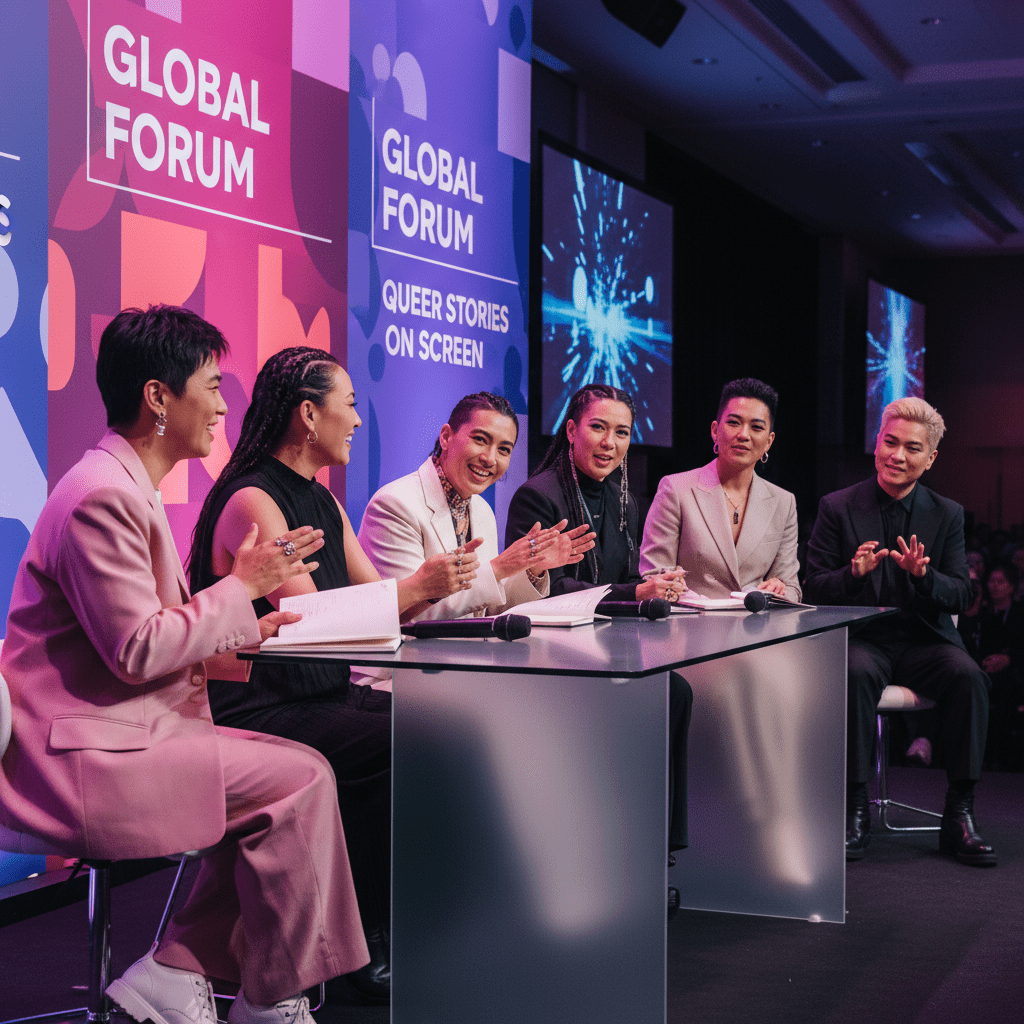LGBTQ+ Filmmaking Summits: Where Asian Queer Cinema is Headed 
The conversation around queer cinema in Asia is no longer whispered in back-room sit’s being declared on stages, at summits, in festivals with panels, grants, workshops, and fierce networking. These filmmaking summits and industry forums are becoming the engines powering LGBTQ cinema forward: more inclusive funding, more nuanced stories, more visibility for underrepresented voices in queer India and beyond.
The New Summit Ecology in Asian Queer Cinema
There was a time when queer Asian filmmakers had to hustle alone, finding safe spaces, self-funding, dealing with censorship, and hoping their short films might get noticed in global festivals. In 2025, though, things are shifting.
Festivals like KASHISH Pride Film Festival (Mumbai, India) are not just screening queer films they’re running film grants, poster contests, panel discussions, and open calls specifically for women, transgender, intersex, and nonbinary filmmakers.
 Elsewhere in Asia, the Hong Kong Lesbian & Gay Film Festival (HKLGFF) is amplifying queer powerful narratives under threat, creating “Asian Focus” programs, spotlighting regional filmmakers, and using summits and Q&A sessions to engage with issues like censorship, identity, and family.
Elsewhere in Asia, the Hong Kong Lesbian & Gay Film Festival (HKLGFF) is amplifying queer powerful narratives under threat, creating “Asian Focus” programs, spotlighting regional filmmakers, and using summits and Q&A sessions to engage with issues like censorship, identity, and family.
Summits aren’t always formal “meetings about power” but happen within festivals and forums: workshops, discussions like “Lights, Camera, Inequality” in Kerala’s Sambhav 2025, or storytelling labs, mentorships, and “Queer Movie Talks” in Korea’s Queer Film Festival.
What These Forums Are Achieving (And Where They’re Still Behind)
These summits and festival forums are delivering real change but also exposing gaps.
What’s improving:
- Story diversity: Films from rural regions, feminine queer perspectives, nonbinary & intersex stories are making their way into official selections more often. Kashmir’s Trans Kashmir doc by S.A. Hanan & Surbhi Dewan was featured in virtual Pride cinema programs.
- Access and inclusion: Online streaming & virtu
 al festival editions (for example, KASHISH 2025 went partly virtual) ensure that people in smaller towns or those who must hide their identity can view queer cinema safely.
al festival editions (for example, KASHISH 2025 went partly virtual) ensure that people in smaller towns or those who must hide their identity can view queer cinema safely.
- Capacity building: Grants, workshops, peer discussions, mentorships are helping filmmakers refine craft, understand storytelling with queer sensitivity, navigate legal and social restrictions.
What still needs more work:
- Funding & infrastructure: High-quality queer feature film or series still struggle to get funding unless backed by prestige. Many summits call for entries, but few provide ongoing production support.
- Distribution & mainstream reach: Even when queer films are made, many remain in festival circuits or OTT niche spaces; theatrical release, mass promotion, or broadcast remains limited.
- Safe storytelling environments: Censorship boards, societal taboos, backlash still affect creative freedom. Queer filmmakers often self-censor themes around sex, intersex, or relationship dynamics that defy conservative norms.
- Intersectional representation: Caste, class, disability, region are still underrepresented in summit lineups. Queer stories from Northeast India, from Dalit lesbians, from disabled queer people need more platforms.
A View from India: KASHISH, Out & Loud, Sambhav
In India, festivals are doing more than screening films they’re becoming summits themselves: spaces of advocacy, mentorship, and resource sharing.
- KASHISH 2025 in Mumbai framed itself with global film selections (152 films, 48 countries) while also emphasizing South Asian queer voices. It opened and closed with big titles, included panels, and offered grants.
- Out & Loud, Pune grew from a local queer film showcase to an internationally recognised queer cinema celebration that also pairs with Pune Queer Pride, bridging activism with art.
- Sambhav 2025 in Kochi is smaller but important: it centred gender equity, diversity, and inclusion; its workshops (e.g., “Framing Men, Blurring Women”) are prompting filmmakers and audiences to rethink narrative power.
These Indian forums are showing what queer filmmaking summits can do: offer funding, amplify stories from across caste, class, and region, build networks, and pressure institutions to be more inclusive.
Where Queer Asian Cinema Is Headed 
Putting together what summits, festival panels, and queer film funding bodies are doing, here are the directions Asian queer cinema seems to be moving toward:
More regional queer voices from Myanmar, Indonesia, Northeast India, and Central Asia. Stories not filtered through metropolitan sensibilities. Hybrid storytelling mixing documentary, fiction, experimental filmmaking; cinema that blurs genres and format (shorts, VR, digital first). Queer cinema + mainstream crossover, more queer stories getting theatrical release, inclusion in mainstream streaming platforms, Bollywood/Bollywood adjacent productions taking risks. Intersectional inclusion films that speak not just about sexuality/gender, but also caste, religion, disability, region. Sustainable ecosystems actual production grants, legal protections, supportive censorship regimes, mentorship infrastructure, and fair pay for queer artists.
Practical Takeaways for Filmmakers & Allies
If you’re a queer filmmaker, festival organiser, or someone who wants to move Asian queer cinema forward, here are things you can do:
- Pitch your work to summits & festivals with queer or feminist wings; apply for mentorships and film grants early.
- Form collectives across regions (NE India, Southeast Asia, Central Asia) to share resources, co-produce, translate, and subtitle.
- Leverage online platforms & virtual festivals to reach audiences beyond big cities.
- Be authentic: tell your voice, culture, identity without conforming to what the mainstream expects. Intersectionality strengthens your story.
- Push for institutional change: demand that subsidies, funding, and policy recognise LGBTQ cinema as part of national cinema, not fringe.
A Future in Motion
Asian queer cinema in 2025 is in motion, no longer waiting for permission, but building stages, creating summits, and making stories. These gatherings are more than events; they’re lifelines and launchpads for queer voices that have long been sidelined. As queer India and the broader Asian queer community continue to connect, collaborate, and claim space, the horizon is wide and the film reels are rolling.



